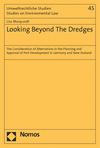Looking Beyond The Dredges
The Consideration of Alternatives in the Planning and Approval of Port Development in Germany and New Zealand
Zusammenfassung
Die Betrachtung von Alternativen als Teil von Planungs- und Genehmigungsprozessen von Infrastrukturgroßvorhaben ist seit gut zwei Jahrzehnten fest im internationalen und nationalen Umweltrecht etabliert. In jüngerer Vergangenheit haben verstärkte Konflikte um einzelne Vorhaben wie „Stuttgart 21“ und Rufe nach einer neuen Beteiligungskultur die Frage, wer wann und wie bei der Entwicklung und Auswahl von Planungs- und Projektalternativen beteiligt werden soll, neu aufgeworfen. Dieser Frage widmet sich das Werk zunächst konzeptionell, bevor es die Verankerung der Alternativenprüfung im deutschen und neuseeländischen Planungs- und Genehmigungsrecht sowie deren Implementierung in der Praxis anhand von zwei Fallbeispielen für Hafenentwicklung untersucht. Der Vergleich der beiden Systeme ermöglicht Rückschlusse auf den Mehrwert der Alternativenprüfung als Instrument des Umweltrechts sowie die Identifikation von begünstigenden und hemmenden Faktoren für dessen Implementierung.
Abstract
A key question in environmental impact assessment is whether a project should be considered on its own or in a broader context that includes alternative projects. While at first sight a broader view is desirable, it is not easy to evaluate the environmental effects of hypothetical projects. Intensified conflicts over major infrastructure development projects and calls for extended participation have lately raised interest in the question of choices between alternatives. This book first introduces a conceptual framework for the consideration of alternatives. It proceeds with a close comparative analysis of the presence of such requirements in German and New Zealand law, and then examines their operation in practice. With a comparison of two case studies concerning the dredging of port waterways, the author has drawn conclusions about the value of the consideration of alternatives as a tool, and has identified factors that foster or hinder its implementation in practice.
- Kapitel Ausklappen | EinklappenSeiten
- 23–28 I. Introduction 23–28
- 29–64 II. Background 29–64
- 379–380 VI. Final conclusion 379–380
- 381–386 List of cases 381–386
- 387–410 Bibliography 387–410

